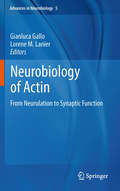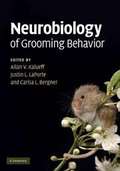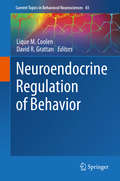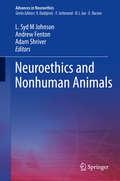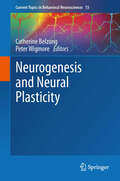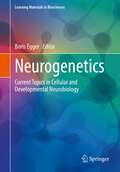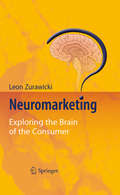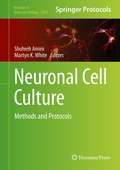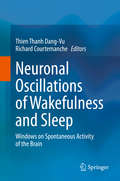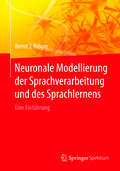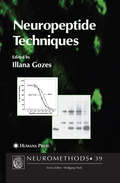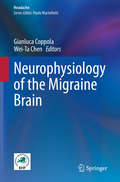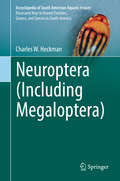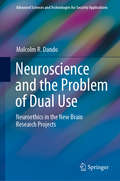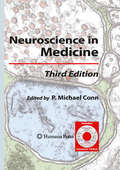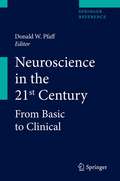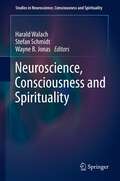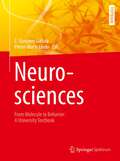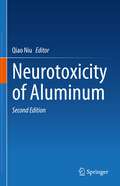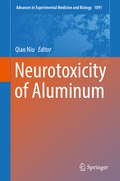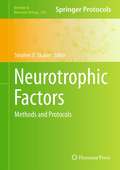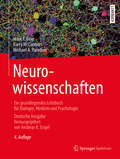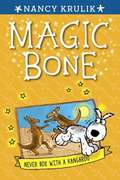- Table View
- List View
Neuroathletics for Riders
by Marc NolkeUsing the power of brain science to unlock the equestrian body&’s full potential.Every movement of the rider's body starts in the brain. In these pages, Olympic competitor and coach Marc Nölke explains how to direct the specific areas of the brain that control stability, sense of rhythm, precision of movement, breathing, and vision. With his unique brain-focused exercises, riders learn how to change theinputsent to their brain to get healthier, more athleticoutput, which can include intentional and unintentional movement, and functions of circulatory, hormonal, or immune systems.The brain decides how you ride and how you feel when you ride based on theinputyou send it. Traditionally equestrians have worked to improve the brain'soutput(riding skills) by training theoutput(riding skills). Nölke's innovative &“Neuro-Rider Program&” is based on achieving betteroutput(better riding skills), not by endlessly practicing the movements, but instead by changing theinput—what you send to your brain for it to process and interpret.In a series of over 40 unique exercises, Nölke helps riders improve the signals they send to their brain from the:Proprioceptive systemVisual systemVestibular systemRespiratory systemRegular practice will improve the rider's overall performance as well as address specific issues, such as:Coordination and fine-tuning of the aidsBody symmetryHead postureHand positionAnxiety in certain situationsInappropriate emotions and emotional responsesDifficulties with rhythmUnlevel hipsShoulder crookednessFocus and concentrationIn time, Neuro-Rider training will make you feel lighter on horseback, help you follow the horse's movements more naturally, increase your relaxation in the saddle, and enable you to become more effective overall. With options to perform exercises on or off the horse, this book offers a practical way for any rider—regardless of age, ability, discipline, or time—to steadily improve in distinct and profound ways.
Neurobiology of Actin
by Gianluca Gallo Lorene M LanierThis text is an introduction to the interface between the actin cytoskeleton and the myriad of issues fundamental to the understanding of the nervous system. It covers the neurobiology of actin ranging from basic cellular organization and function to the roles of actin in the health and disease states of the nervous system. Its opening chapter presents the fundamental concepts required to appreciate the details of the molecular machinery that regulates actin in a cellular context, setting the stage for the first part of the book which reviews the neurobiology of actin at the cellular level. The latter section of the book then discusses the functions of actin in the context of neurobiological issues ranging from early development to synaptic function and disease states of the nervous system. This text is intended for neuroscientists interested in investigating the actin cytoskeleton in the context of their particular neuroscience research program, and its chapters are cross-referenced in order to assist readers in finding relevant information that is covered in greater depth in other chapters.
Neurobiology of Grooming Behavior
by Allan V. Kalueff Justin L. Laporte Carisa L. BergnerGrooming is among the most evolutionary ancient and highly represented behaviours in many animal species. It represents a significant proportion of an animal's total activity and between 30-50% of their waking hours. Recent research has demonstrated that grooming is regulated by specific brain circuits and is sensitive to stress, as well as to pharmacologic compounds and genetic manipulation, making it ideal for modelling affective disorders that arise as a function of stressful environments, such as stress and post-traumatic stress disorder. Over a series of 12 chapters that introduce and explicate the field of grooming research and its significance for the human and animal brain, this book covers the breadth of grooming animal models while simultaneously providing sufficient depth in introducing the concepts and translational approaches to grooming research. Written primarily for graduates and researchers within the neuroscientific community.
Neuroendocrine Regulation of Behavior (Current Topics in Behavioral Neurosciences #43)
by Lique M. Coolen David R. GrattanThis special volume provides twelve contributions that discuss different aspects of social and endocrine behaviors with an emphasis on the neural regulation of these behaviors. In addition, several review chapters address the neural plasticity that results from exposure to hormones or the experiences with the behavior. Finally, each of the contributions emphasizes future directions and incorporation of newly developed neuroscience techniques and approaches.
Neuroethics and Nonhuman Animals (Advances in Neuroethics)
by Andrew Fenton L. Syd M Johnson Adam ShriverThis edited volume represents a unique addition to the available literature on animal ethics, animal studies, and neuroethics. Its goal is to expand discussions on animal ethics and neuroethics by weaving together different threads: philosophy of mind and animal minds, neuroscientific study of animal minds, and animal ethics. Neuroethical questions concerning animals’ moral status, animal minds and consciousness, animal pain, and the adequacy of animal models for neuropsychiatric disease have long been topics of debate in philosophy and ethics, and more recently also in neuroscientific research. The book presents a transdisciplinary blend of voices, underscoring different perspectives on the broad questions of how neuroscience can contribute to our understanding of nonhuman minds, and on debates over the moral status of nonhuman animals. All chapters were written by outstanding scholars in philosophy, neuroscience, animal behavior, biology, neuroethics, and bioethics, and cover a range of issues and species/taxa. Given its scope, the book will appeal to scientists and students interested in the debate on animal ethics, while also offering an important resource for future researchers. Chapter 13 is available open access under a CC BY 4.0 license at link.springer.com.
Neurogenesis and Neural Plasticity
by Catherine Belzung Peter WigmoreThis volume brings together authors working on a wide range of topics to provide an up to date account of the underlying mechanisms and functions of neurogenesis and synaptogenesis in the adult brain. With an increasing understanding of the role of neurogenesis and synaptogenesis it is possible to envisage improvements or novel treatments for a number of diseases and the possibility of harnessing these phenomena to reduce the impact of ageing and to provide mechanisms to repair the brain.
Neurogenetics: Current Topics in Cellular and Developmental Neurobiology (Learning Materials in Biosciences)
by Boris EggerThis textbook provides students with knowledge of neurogenetics, neurogenesis, neuronal specification and function, neuronal networks, learning and memory formation, brain evolution, and neurodegenerative diseases.Students are introduced to topics of classical developmental genetics as well as modern molecular and neurogenetic methods. Using a wealth of examples from current research, the textbook takes a strong applied approach. Using animal models such as Drosophila melanogaster and Caenorhabditis elegans as well as mammalian systems, the interrelationships between genes, neurons, nervous systems, and behaviour under normal and pathological conditions are illustrated. The textbook aims encourage students to address biological questions in neurogenetics and to think about the design of their own experiments. It targets primarily master and graduate students in neurobiology, but is also a valuable teaching tool for instructors in these fields.
Neuromarketing
by Leon ZurawickiOver the last 10 years advances in the new field of neuromarketing have yielded a host of findings which defy common stereotypes about consumer behavior. Reason and emotions do not necessarily appear as opposing forces. Rather, they complement one another. Hence, it reveals that consumers utilize mental accounting processes different from those assumed in marketers' logical inferences when it comes to time, problems with rating and choosing, and in post-purchase evaluation. People are often guided by illusions not only when they perceive the outside world but also when planning their actions - and consumer behavior is no exception. Strengthening the control over their own desires and the ability to navigate the maze of data are crucial skills consumers can gain to benefit themselves, marketers and the public. Understanding the mind of the consumer is the hardest task faced by business researchers. This book presents the first analytical perspective on the brain - and biometric studies which open a new frontier in market research.
Neuronal Cell Culture: Methods and Protocols
by Martyn K. White Shohreh AminiIn Neuronal Cell Culture: Methods and Protocols, the latest aspects of the culture of neural cells are explored by experts in the field who also explain the practical and theoretical considerations of the techniques involved. Starting with a general overview of the neuronal culturing principles that are described, this detailed volume covers cell line models for neural cells, the isolation and propagation of primary cultures, stem cells, transfection and transduction of neural cultures, and other more advanced techniques. Written for the Methods in Molecular Biology series, chapters include introductions to their respective topics, lists of the necessary materials and reagents, step-by-step, readily reproducible laboratory protocols, and tips on troubleshooting and avoiding known pitfalls. Practical and easy to use, Neuronal Cell Culture: Methods and Protocols will be of interest to scientists at all levels developing cell culture models for neuroscientific studies.
Neuronal Oscillations of Wakefulness and Sleep: Windows on Spontaneous Activity of the Brain
by Thien Thanh Dang-Vu Richard CourtemancheThe purpose of this work is to review recent findings highlighting the mechanisms and functions of the neuronal oscillations that structure brain activity across the sleep-wake cycle. An increasing number of studies conducted in humans and animals, and using a variety of techniques ranging from intracellular recording to functional neuroimaging, has provided important insight into the mechanisms and functional properties of these brain rhythms. Studies of these rhythms are fundamental not only for basic neuroscience, but also for clinical neuroscience. At the basic science level, neuronal oscillations shape the interactions between different areas of the brain and profoundly impact neural responses to the environment, thereby mediating the processing of information in the brain. At the clinical level, brain oscillations are affected in numerous neurological conditions and might provide useful biomarkers that inform about patients’ evolution and vulnerability. During sleep, these brain rhythms could provide functional support to internal states that govern the basic maintenance of local circuit and systemic interactions. During wake, the rhythmicity of cortical and subcortical circuits have been linked with sensory processing, cognitive operations, and preparation for action. This book will attempt to link together these sleep and wake functional roles at the level of neuroimaging and electroencephalographic measures, local field potentials, and even at the cellular level.
Neuronale Modellierung der Sprachverarbeitung und des Sprachlernens: Eine Einführung
by Bernd J. KrögerDieses Buch erläutert die Thematik der Produktion und Wahrnehmung gesprochener Sprache aus neurowissenschaftlicher Sicht. Nach der Darstellung der Grundlagen der Sprachverarbeitung und des Spracherwerbs wird dem Leser ein neurobiologisch basiertes und computerimplementiertes neuronales Simulationsmodell vorgestellt. Diese Einführung in die quantitative und computerimplementierbare Modellierung der Sprachverarbeitung und des Sprachlernens basiert auf einem naturwissenschaftlich orientierten Ansatz zur Beschreibung gesprochener Sprache. Dennoch wird weitgehend auf mathematische Beschreibungen verzichtet.Das Buch spricht Studierende und Wissenschaftler der Bereiche Neurowissenschaften, Informatik, Medizin, Psychologie und Linguistik an, die sich in das Gebiet der Sprachverarbeitung und des Spracherwerbs aus neurowissenschaftlicher Sicht einarbeiten möchten. Es richtet sich aber auch an Anwender, die sich mit der Entwicklung von Software zur Sprachverarbeitung befassen.
Neuropeptide Techniques
by Illana GozesNeuropeptides exhibit multiple functions as hormones and regulators. As such, many techniques are required to understand the contribution and functions of neuropeptides in health and disease processes. Research in the neuropeptide field is aimed toward a better understanding of the physiology of the human body and toward the development of better diagnostics and therapeutics. This book will familiarize the audience with forefront techniques in the field.
Neurophysiology of the Migraine Brain (Headache)
by Gianluca Coppola Wei-Ta ChenRoughly one in every five patients referred to a neurologist suffers from headaches; the majority have migraines. Although headache specialists understand migraine on a clinical basis, the pathophysiological changes that provoke and accompany the development of a migraine attack continue to elude us. Several decades have passed since the pioneering electroencephalographic study by Golla and Winter (1959), which underscored the role of abnormal rhythmic activities in migraine. Since then, there have been substantial advances in the field; a wealth of neurophysiological studies has enriched our understanding of the pathophysiological facets of the migraine pathology. Virtually every known technique of clinical electrophysiology has since been used to study the migraine brain and, more recently, new neurophysiological tools have been added to the arsenal. Nevertheless, applying the principles of peripheral and central neuromodulation offers a promising way to transfer the principles of synaptic plasticity to the patient’s bedside. This book belongs to the Headache Series endorsed by the European Headache Federation. Written by internationally recognized experts in their respective fields, it covers all aspects of clinical neurophysiological methods that represent significant advances in our understanding of the pathophysiology of migraine. It will offer a valuable toolkit for beginners, and a reference guide for experts.
Neuroptera (Including Megaloptera)
by Charles W. HeckmanThis order once encompassed all insects with a complex network of wing veins, regardless of whether their metamorphosis was incomplete or complete. By the early 20th century, most of the species had been transferred to new orders, leaving only a small percentage of the insects once assigned to the Neuroptera remaining in that order. By the second half of the 20th century, some of the taxonomists began to believe that the fragmentation of this order had gone too far, and that the order Megaloptera needed to be grouped in some way with Neuroptera, either by making them suborders of the same order or by creating a superorder to accommodate both. This volume provides a discussion of both taxa, tentatively regrouping both in the order Neuroptera. While all known species of Megaloptera in South America have completely aquatic larval stages, few species in the suborder Planipennia, formerly called Neuroptera sensu stricto, are aquatic during any of their life stages. The most interesting of the exceptions are species in the family Sisyridae, some of which develop as larvae inside freshwater sponges. Because only a relatively small number of species are still included in Neuroptera sensu lato, this book provides keys to all known South American species that have been described well enough to be identified with any degree of certainty. Many species in the family Chloropidae, the neuropteran family with the greatest number of recognized species in South America, have proven to be valuable as biological controls for insect pests in agriculture. Their importance for tropical agriculture is another reason for including terrestrial species in this book. The series will continue with volumes providing keys to identify species of other South American orders, but in most cases, only aquatic insects can be included in the keys to the species.
Neuroscience and the Problem of Dual Use: Neuroethics in the New Brain Research Projects (Advanced Sciences and Technologies for Security Applications)
by Malcolm R. DandoThis book discusses recent brain research and the potentially dangerous dual-use applications of the findings of these research projects. The book is divided into three sections: Part I examines the rise in dual-use concerns within various state’s chemical and biological non-proliferation regime’s during this century, as well as the rapid technologically driven advances in neuroscience and the associated possible misuse considerations in the same period. Part II reviews the brain research projects in the EU, USA, Japan, China and several other countries with regard to their objectives, achievements and measures to deal with the problem of dual-use. Part III assesses the extent to which the results of this civil neuroscience work, which is intended to be benign, are being, and could be protected against future hostile applications in the development of novel chemical and biological weapons.
Neuroscience in Medicine
by P. Michael ConnContinuing progress has been made in understanding the brain at the molecular, anatomic, and physiological levels in the years following the "Decade of the Brain," with the results providing insight into the underlying basis of many neurological disease processes. In Neuroscience in Medicine, Third Edition, a distinguished panel of basic and clinical investigators, noted for their teaching excellence, provide thoroughly updated and revised chapters to reflect these remarkable advances. Designed specifically for medical students and allied health professionals, this up-to-date edition alternates scientific and clinical chapters that explain the basic science underlying neurological processes and then relate that science to the understanding of neurological disorders and their treatment. These popular and now expanded "clinical correlations" cover, in detail, disorders of the spinal cord, neuronal migration, the autonomic nervous system, the limbic system, ocular motility, and the basal ganglia, as well as demyelinating disorders, stroke, dementia and abnormalities of cognition, congenital chromosomal and genetic abnormalities, Parkinson's disease, nerve trauma, peripheral neuropathy, aphasias, sleep disorders and myasthenia gravis. In addition to concise summaries of the most recent biochemical, physiological, anatomical, and behavioral advances, the chapters summarize current findings on neuronal gene expression and protein synthesis at the molecular level. Authoritative and comprehensive, Neuroscience in Medicine, Third Edition provides a fully up-to-date and readily accessible guide to brain functions at the cellular and molecular level, as well as clearly demonstrating their emerging diagnostic and therapeutic importance.
Neuroscience in the 21st Century
by Donald W. PfaffEdited and authored by a wealth of international experts in neuroscience and related disciplines, the aim behind this key new resource is to offer medical students and graduate researchers around the world a comprehensive introduction and overview of modern neuroscience. Neuroscience research is certain to prove a vital element in combating mental illness in its various incarnations, a strategic battleground in the future of medicine, as the prevalence of mental disorders is becoming better understood each year. Hundreds of millions of people worldwide are affected by mental, behavioral, neurological and substance use disorders. The World Health Organization estimated in 2002 that 154 million people globally suffer from depression and 25 million people from schizophrenia; 91 million people are affected by alcohol use disorders and 15 million by drug use disorders. A more recent WHO report shows that 50 million people suffer from epilepsy and 24 million from Alzheimer's and other dementias. Because neuroscience takes the etiology of disease--the complex interplay between biological, psychological, and sociocultural factors--as its object of inquiry, it is increasingly valuable in understanding an array of medical conditions. A recent report by the United States' Surgeon General cites several such diseases: schizophrenia, bipolar disorder, early-onset depression, autism, attention deficit/ hyperactivity disorder, anorexia nervosa, and panic disorder, among many others. Not only is this volume a boon to those wishing to understand the future of neuroscience, it also aims to encourage the initiation of neuroscience programs in developing countries, featuring as it does an appendix full of advice on how to develop such programs. With broad coverage of both basic science and clinical issues, comprising 106 chapters from a diversity of international authors and including complementary video components, Neuroscience in the 21st Century will serve as a comprehensive resource to students and researchers alike.
Neuroscience, Consciousness and Spirituality
by Wayne B. Jonas Harald Walach Stefan SchmidtNeuroscience, Consciousness and Spirituality presents a variety of perspectives by leading thinkers on contemporary research into the brain, the mind and the spirit. This volumes aims at combining knowledge from neuroscience with approaches from the experiential perspective of the first person singular in order to arrive at an integrated understanding of consciousness. Individual chapters discuss new areas of research, such as near death studies and neuroscience research into spiritual experiences, and report on significant new theoretical advances. From Harald Walach's introductory essay, "Neuroscience, Consciousness, Spirituality - Questions, Problems and Potential Solutions," to the concluding chapter by Robert K. C. Foreman entitled "An Emerging New Model for Consciousness: The Consciousness Field Model," this book represents a milestone in the progress towards an integrated understanding of spirituality, neuroscience and consciousness. It is the first in a series of books that are dedicated to this topic.
Neurosciences - From Molecule to Behavior: a university textbook
by Pierre-Marie Lledo C. Giovanni GaliziaNeurosciences - a comprehensive approach This textbook covers neuroscience from cellular and molecular mechanisms to behavior and cognitive processing. We also address evolution of the nervous system, computational neuroscience, the history of neuroscience as a discipline and neurophilosophy - to name but a few. The book provides the newest state-of-the-art knowledge about neuroscience from across the animal kingdom, with particular emphasis on model species commonly used in neuroscience labs across the world: mouse, zebra fish, fruit fly, honeybee, and nematode worm. We aim at university students of neuroscience, psychology, biological sciences, and medical sciences, but also computer scientists, philosophers, or anybody interested in understanding how brains work.
Neurotoxicity of Aluminum
by Qiao NiuThis book reviews the scientific literature and the authors’ own research linking aluminum neurotoxicity with cognitive impairment and Alzheimer’s disease (AD). It focuses on aluminum levels in the brain, region-specific and subcellular distribution, its relation to neurofibrillary tangles and amyloid beta—the pathological features of AD, and the possible mechanism of aluminum inducing these pathological features. Further, the book stresses the importance of aluminum’s complex speciation chemistry in relation to biology, and details aluminum’s mechanism in oxidative stress and cell death, especially in connection with apoptosis and necroptosis. The electrophysiological variation and synaptic plasticity induced by aluminum are covered, while the metal’s debatable role in AD and the cross-talk between aluminum and genetic susceptibility are also discussed, and more recently the relationship between aluminum-induced epigenetic modification on DNA and non-coding RNAs and neuron death and synaptic impairment.The second edition updates eight chapters according to the most recent researches. Content about aluminum-induced AD-like pathological features, neurotoxic effects of aluminum and aluminum alloy nanoparticles(TBD) and alumina nanoparticles induced neurotoxic and neurodevelopmental toxic effects is also added. In closing, this book provides readers with a systematic summary of aluminum neurotoxicity.
Neurotoxicity of Aluminum (Advances in Experimental Medicine and Biology #1091)
by Qiao NiuThis book reviews the scientific literature and the authors’ own research linking aluminum neurotoxicity with cognitive impairment and Alzheimer’s disease (AD). It focuses on aluminum levels in the brain, region-specific and subcellular distribution, and its relation to neurofibrillary tangles and amyloid beta. Further, the book stresses the importance of aluminum’s complex speciation chemistry in relation to biology, and details aluminum’s mechanism in oxidative stress and cell death, especially in connection with apoptosis and necroptosis. The electrophysiological variation and synaptic plasticity induced by aluminum are covered, while the metal’s debatable role in AD and the cross-talk between aluminum and genetic susceptibility are also discussed. In closing, the book reviews the neurotoxic effects of aluminum and its important role in the pathogenesis of AD. Given its depth of coverage, the book provides readers with a systematic summary of aluminum neurotoxicity.
Neurotrophic Factors
by Stephen D SkaperNervous system development evolves from the well-orchestrated processes of neural induction, cell proliferation, differentiation, cell migration, survival, and synapse formation. Among these environmental cues, neurotrophic factors are secreted proteins that promote neurite outgrowth, neuronal cell differentiation and survival both in vivo and in vitro. Nerve growth factor (NGF) is the founding and best characterized member of the neurotrophin family of neurotrophic polypeptides. Neurotrophic Factors: Methods and Protocols presents a selection of protocols and procedures which make use of cellular, tissue, and whole animal models which can be applied to the investigation of neurotrophic factors and other agents impacting on these systems. Chapters cover a wide-range of topics such as dealing with the culture of neurons and glia from the central and peripheral nervous systems, neuron-glia co-culture models, and cell-based assays for the evaluation of neuroprotective molecules, as well as assays which can be applied to the study of agents with neuroregenerative potential. Protocols describing viral- and nanoparticle-based delivery methods to neural cells are also presented, following by chapters dealing with organotypic slice culture protocols. Lastly, several chapters are dedicated to in vivo lesion models of relevance to nervous system pathology, which can be applied to the investigation of neurotrophic factors and peptides. Written in the successful Methods in Molecular BiologyTM series format, chapters include introductions to their respective topics, lists of the necessary materials and reagents, step-by-step, readily reproducible protocols, and notes on troubleshooting and avoiding known pitfalls. Authoritative and easily accessible, Neurotrophic Factors: Methods and Protocols seeks to serve both professionals and novices alike with its well-honed methodologies in an effort to further our knowledge of what has been described as the last frontier of science.
Neurowissenschaften: Ein Grundlegendes Lehrbuch Für Biologie, Medizin Und Psychologie
by Mark F. Bear Michael A. Paradiso Monika Niehaus-Osterloh Barry W. Connors Andreas K. Engel Andreas HeldDer perfekte Einstieg in die Neurowissenschaften – ideal zum Verstehen und LernenSeit vielen Jahren zählt diese didaktisch durchdachte, verständlich geschriebene und hervorragend illustrierte Einführung international zu den führenden Lehrbüchern im Bereich der Neurowissenschaften. Das moderne Grundlagenwerk richtet sich an Studierende der Biologie, der Medizin und der Psychologie gleichermaßen. Die wieder von Andreas Engel herausgegebene deutsche Ausgabe ist an die hiesige Studiensituation angepasst und stellenweise erweitert. Der Bogen spannt sich von der Anatomie des Gehirns bis zur Sinnesphysiologie, von der Entwicklungsbiologie bis zum Verhalten, von den Störungen des Nervensystems bis zur Kognitionswissenschaft, von den molekularen Mechanismen bis zu den neuen bildgebenden Verfahren. Ein eigenständiger „Bildatlas der menschlichen Neuroanatomie“ erlaubt dem Lernenden, seine Kenntnisse der Hirnstrukturen zu überprüfen und zu erweitern. Jedes Kapitel endet mit Verständnisfragen und Übungsaufgaben sowie einer Zusammenstellung wichtiger weiterführender Literatur. In spannenden Exkursen berichten renommierte Wissenschaftler, wie sie zu ihren entscheidenden Entdeckungen kamen. So führt das Buch den Leser von den Grundlagen zu den aktuellen Forschungsthemen des Faches.In der durchgehend aktualisierten 4. Auflage sind unter anderem neue Forschungsergebnisse zu Optogenetik, Konnektomik, tiefer Hirnstimulation, molekularer Medizin und Neuroökonomie eingearbeitet worden. Zahlreiche neue oder aktualisierte Abbildungen veranschaulichen in bewährter Manier die im Text beschriebenen Prozesse, Strukturen und Methoden. Wer Neurowissenschaften in ihrer ganzen Bandbreite verstehen will, ist mit "dem Bear" bestens bedient. Den drei Verfassern des Buches gelingt, womit Lehrbuchautoren im deutschsprachigen Raum sich nach wie vor schwer tun: anschaulich und spannend den Leser vom Einstieg in die Grundlagen bis an die vorderste Front der Forschung mitzunehmen und ohne überflüssigen Ballast wissenschaftliche Erkenntnis mehr erzählend als erklärend zu vermitteln … Ein didaktisches Meisterwerk ist nun topaktuell auch in deutscher Sprache neu aufgelegt verfügbar. Aus dem Vorwort von Prof. Andreas K. Engel, Universitätsklinikum Hamburg-Eppendorf
Never Box with a Kangaroo #11
by Nancy Krulik Sebastien BraunSparky goes down under!When Sparky chomps on his magic bone, this time it kabooms him to Kangaroo Island, Australia! There he discovers a fox terrier puppy named Mick who's lost his family. But Sparky has a plan--he'll help Mick find a new family! They ask everyone they come across: bats, penguins, kangaroos, even bees! But will anyone give Mick a home?

